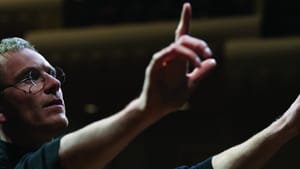Stay in the Loop
BSR publishes on a weekly schedule, with an email newsletter every Wednesday and Thursday morning. There’s no paywall, and subscribing is always free.
The man behind the curtain
Danny Boyle's 'Steve Jobs'

Since the death of Steve Jobs in 2011, there have been more than a dozen documentaries, feature films, and television specials revolving around the major events in his career. By now, we know the facts and what happened — his exit from Apple and his return — but when you combine the poetic dialogue of Aaron Sorkin, the unconventional storytelling of Danny Boyle, and the incredible talent of Michael Fassbender, Kate Winslet, and Jeff Daniels, you get Steve Jobs, a movie that's based on the facts but assumes you already know what those facts are. In this movie, it’s all about Steve. His arrogant, assholish nature mixed with the wit of a mad scientist makes him the monster. It’s easy to hate him, but the character is layered so deeply, it’s hard to look away.
Michael Fassbender does a superb job portraying Jobs. Although he looks nothing like him, he creates a version of Jobs that fits the reality of the movie. It feels more like a stage play, due to the signature writing style of Sorkin, but Steve Jobs is not a documentary or biopic.
The film takes place on three particular days: the launch of the Macintosh computer in 1984, the unveiling of the NeXT computer in 1988, and the presentation of the iMac in 1998. On each of these three days we meet a new Steve Jobs. We also see the changes in important relationships: the friendship with his old partner Steve Wozniak (Seth Rogen), his stability with his “work wife” (Kate Winslet), and, most importantly, the connection he shares with his estranged daughter. The 1984 Steve is young, cocky, and almost vulnerable. Four years later, he is still a jerk. In 1998, we meet an older, wiser Steve, with all his relationships at pinnacle moments. Each will be destroyed or mended based on the actions he chooses to take.
Redeeming a backstabber
The movie’s failure is the result of Sorkin and Boyle trying to redeem Steve, despite all his insults and backstabbing. A more open-ended conclusion and a subtler hint of “softness” from the man would have triggered a more sustainable reaction. Still, they effectively show how messy and chaotic Jobs’s life actually is. In the foreground he displays sleek, beautiful technology, while backstage he is desperately trying to maintain his image and prevent his alter-personality from slipping out of control.
When all the elements come together, Steve Jobs, unlike the numerous portrayals that preceded it, looks behind the mask of the man who changed the way we look at and use technology. It breezes over the parts we already know, but focuses closely on the interactions with the most important people in his life. It states powerfully that without the help of his friends, coworkers, and family, there would have not been Apple — and there would not have been a Steve Jobs.
What, When, Where
Steve Jobs. Danny Boyle directed. Written by Aaron Sorkin, based on the book by Walter Isaacson. Philadelphia area showtimes.
Sign up for our newsletter
All of the week's new articles, all in one place. Sign up for the free weekly BSR newsletters, and don't miss a conversation.